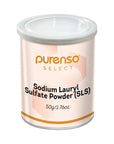



Sodium Lauryl Sulfate SLS Powder
| Description | Sodium Lauryl Sulfate (SLS) is a strong, anionic surfactant that is considered milder than sodium laureth sulfate (SLES) but has very similar properties. Sulfates are stable in bases at a higher pH, with good foaming properties. |
| INCI | Sodium Lauryl Sulfate |
| Appearance | White powder |
| Usage rate | Can be added to formulas as is. Recommended use level 3 - 30% depending on desired foaming and cleansing effects. Can be used at higher concentrations for bubble baths. |
| Applications | Body washes, shampoos, bubble baths, cleansing lotions, various personal care cleansing products |
| Scent | Characteristic of surfactants—detergenty |
| pH | 9.75–10.25 (1% solution) |
| Charge | Anionic |
| Solubility | Water |
| Why do we use it in formulations? | Sodium Lauryl Sulfate (SLS) is an excellent cleanser and creates wonderful, luxurious lather. It’s also inexpensive. |
| Refined or unrefined? | Sodium Lauryl Sulfate (SLS) only exists as a refined product |
| Strengths | Strong, inexpensive, effective surfactant |
| Alternatives & Substitutions | Would choose something milder, like Sodium Coco Sulfate (SCS), Sodium Laureth Sulfate (SLeS), or Sodium Lauryl Sulfoacetate (SLSa). |
| Tips, Tricks, and Quirks |
Sodium Lauryl Sulfate (SLS) is often confused with Sodium Laureth Sulfate (SLeS) and Sodium Lauryl Sulfoacetate (SLSa), which are both different (and milder) surfactants. While SLS certainly can be irritating, so can many ingredients (traditional lye soap, for instance, would also be irritating to the skin if applied in high concentrations and left in contact with the skin for extended periods of time). SLS is not a carcinogen. |
| Benefits |
|
This product is a cosmetic raw material and is intended for external use only in cosmetic and personal care formulations. It is not intended for internal consumption or medicinal use.
- Do not ingest.
- Keep out of reach of children.
- Avoid direct contact with eyes.
All product images are for illustrative purposes only. Actual product color, texture, or packaging may vary from batch to batch.
Information provided on this website is for educational purposes only and should not be considered or interpreted as medical advice.
While we do not offer products for internal use, we source only high-quality, pharmaceutical or food-grade ingredients. Ingredient purity and performance are critical in cosmetic applications, just as they are in ingestible products.
Please note:
Just because two products have the same name or CAS number does not guarantee the same grade, purity, or effectiveness. Always choose trusted suppliers. Choose Purenso for premium-grade ingredients you can rely on.
FREQUENTLY ASKED QUESTIONS




